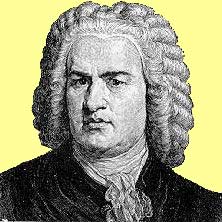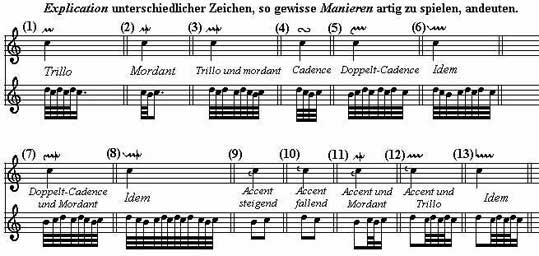
Bach ornaments
The following ornament table is a transcription of the one appearing in the Clavier-Büchlein vor Wilhelm Friedemann Bach, written by Johann Sebastian Bach for the keyboard instruction of his eldest son. (A scan of the original manuscript appears at Dave`s J.S. Bach Page.) The German title translates as "Explanation of various signs, showing how to play certain ornaments correctly."{1} Bach gives the sign for each ornament on the upper of the paired staves, while the lower shows its execution directly beneath. I have simply modernized the clefs in my transcription, since Bach`s manuscript uses soprano clefs, as several composers continued to do throughout the 18th century in place of the treble clef now used in all keyboard music. The graphic of the transcription is image-mapped, meaning that you can click on any of the ornaments and hear an AU sound file play its execution. After the table, there appear clickable buttons which are keyed to the same AU sound files; some may find these more convenient to use than the image map. Such a table as this, coming from the hand of the great J.S. Bach himself, is obviously valuable for the help it gives us in interpreting the signs he used for ornaments. Because the execution of ornaments often varied in the 18th century from country to country and from composer to composer, it is good to see Bach specifying what he wants in this regard. Nevertheless, a cautionary note is in order: Willard A. Palmer, in his detailed explanation of this table, helpfully remarks that "Since the Explication applies each ornament to a quarter note only, and that application is only practical at a moderate tempo, it can only show the GENERAL CONFIGURATION of each ornament. Note that all ornaments in the table begin on the beat." {2} This is not really the place for a detailed discussion of the controversy that surrounds some of the finer points of Baroque ornamentation, such as whether a trill should begin on the principal note or the upper auxiliary. C.P.E. Bach`s authority on these matters has been much disputed, but the fact that his own music is very different from his father`s, and the shift that musical idioms underwent after Sebastian`s death, do not necessarily invalidate the application of ornamentation rules from Emanuel`s famous Essay to the music of Sebastian. Since Emanuel promoted his father`s works repeatedly and praised them to the skies--going so far as to say that J.S. Bach "is not in need of my recommendation. One was accustomed to see nothing but masterpieces come from him"{3}--, it does not seem to me reasonable that, if Emanuel`s practice on ornamentation had significantly differed from his father`s, the son would not have indicated as much. Indeed, Willard Palmer`s remark, ". . . I believe that if I could play Bach`s music as well as Karl Philipp Emanuel[,] I would be doing all right,"{4} seems to me to reflect an eminently safe and sane position to take in these matters. In the following graphic of the transcription, I have transcribed Bach`s table as closely as possible, including his original German title and captions. The captions are given in a sometimes-paraphrased English form beside the buttons keyed to the musical examples. I have also added after the paraphrases significant differences found in Palmer, who gives the "most common English names" of these ornaments.

